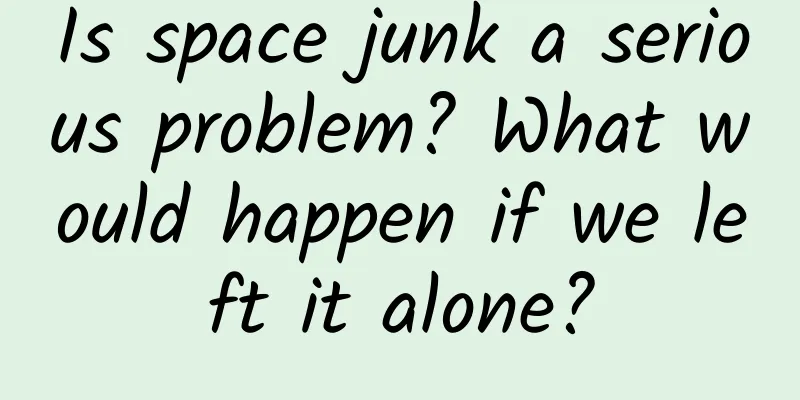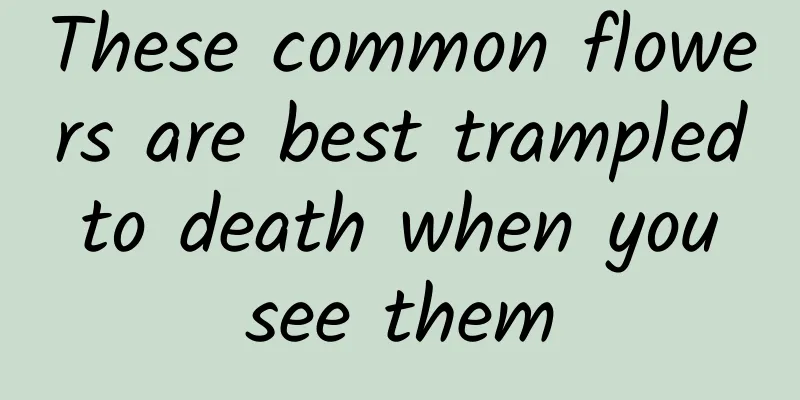Is space junk a serious problem? What would happen if we left it alone?

|
We collect the garbage from our daily work and life and put them into the trash cans, which are then recycled and processed by the municipal departments. Since the beginning of human space activities, the waste generated in space has been mostly discarded on the spot, leaving them in space. These non-functional man-made objects abandoned in space are called "space debris" by aerospace scientists, and they are more commonly known as "space junk." Schematic diagram of space debris situation Who "threw garbage" into space ? In 1989, the space debris monitoring agency discovered that a satellite called the Cosmic Ray Background Explorer produced about 76 pieces of space debris, all of which were larger space debris with a diameter greater than 10 cm. Satellites that fail and disintegrate in orbit are one of the main sources of space debris. Strangely, this satellite continued to work normally after the debris was generated, and did not disintegrate due to abnormal operation. Later, this satellite even successfully completed all observation work within its life cycle, but the cause of the space debris has not been found. Although similar events are rare, the occurrence of this strange phenomenon shows that people still do not fully understand the mechanism of space debris generation. The largest space junk usually comes from failed spacecraft. For example, if a satellite reaches the end of its life span and no deorbiting measures are taken, it will become a "dead star" stranded in orbit. In addition to failed satellites, the second, third or upper stages of rockets that propel satellites into orbit are also one of the main sources of space debris. These spacecraft generally still have some propellant left in them. Within a day or even decades after launch, the remaining propellant may explode, producing a few to hundreds of pieces of space debris, and the flying speeds of these fragments vary. According to the ESA's annual space environment report released in October 2020, space debris produced by the explosion of the remaining parts of rockets is the most dangerous. The collision between failed satellites will turn two large pieces of space debris into a huge amount of space debris. On February 11, 2009, the US communications satellite "Iridium 33" and the Russian satellite "Cosmos 2251" that had been scrapped for many years collided violently over Siberia, causing the first major satellite-satellite collision in human history. This collision produced as many as 2,000 large pieces of space debris, as well as a larger number of small space debris that could not be tracked. In addition, parts and paint flakes that fall off the spacecraft, and even wrenches and tools that astronauts accidentally lose during extravehicular activities, will also become space debris. According to the size, space debris is generally divided into three categories: large debris, dangerous debris and small debris. Among them, the size of large debris is larger than 10 cm. Although the damage may be the greatest, these fragments can be tracked, monitored and catalogued by ground equipment, and working spacecraft can take evasive measures against them. Small fragments less than 1 cm in size cannot be tracked, but their kinetic energy is small, and spacecraft can respond by strengthening protective structures. For fragments between 1 and 10 cm in size, they cannot be tracked and have considerable destructive power. They pose the greatest potential threat to spacecraft, so they are called dangerous debris. According to ESA data, as of January 2020, the number of large debris in space has reached more than 34,000, and the number of dangerous debris is as high as about 900,000. ESA's space debris monitoring system In order to "hide garbage", the International Space Station once urgently avoided In the early morning of July 16, 2015, the Space Debris Monitoring Agency discovered a piece of space junk approaching the International Space Station in a dangerous manner. The piece of space junk, numbered 36912, is about the size of a dinner plate and originated from a disintegrated Soviet military weather satellite. The satellite stopped working more than two years after entering orbit, and in the following decades, debris has been falling off the satellite and becoming space junk. Number 36912 may have once been part of the satellite's heat shield. Due to the special orbit of "No. 36192", only a very small number of stations in the space debris monitoring network can monitor it. The disk-like shape and low mass of "No. 36192" make its orbit easily affected by the changes in the density of the upper atmosphere caused by solar activity. When it reappeared in the monitoring range of the station from the blind spot of monitoring, its orbit may have changed significantly compared with before. In the early morning of the same day, after the space debris monitoring agency updated the orbital data of the debris, it was horrified to find that the debris would approach the International Space Station within a few hours, and the probability of collision had increased to a very high one in a thousand. For daily events in our lives, one in a thousand may be a negligible probability, but because the consequences of a large piece of space debris hitting a spacecraft may be catastrophic, a very low probability is used as the warning threshold when assessing the risk of collision. According to the current collision avoidance procedures for manned spaceflight, when the probability of collision is greater than one in a hundred thousand, the collision risk is medium, and if it does not affect the normal development of the mission, the spacecraft needs to perform orbital maneuvers to avoid space debris. When the probability of collision is greater than one in ten thousand, the spacecraft must perform orbital maneuvers under any circumstances. A one in a thousand collision probability is already a high-risk threat. However, the risk was discovered too late, and it was too late for the International Space Station to avoid the debris. The cabin of the International Space Station has taken into account the protection of space debris when it was designed, and a Whipple shield is installed on the outside of the cabin. This shield is composed of one or more layers of thin metal sheets. When space debris hits the shield, the shield can absorb part of the impact energy and disintegrate the debris, thereby reducing the impact of the debris on the outer wall of the cabin. The Whipple shield is also a device used by most other spacecraft to protect against space debris. However, after estimation, technicians found that the protection capability of the International Space Station was not enough to withstand the impact of "36912". They could only let the astronauts on the space station enter the Russian Soyuz spacecraft docked on the space station for safety, and closed the doors of some cabins. In the event that debris hits the space station, such measures can minimize the impact of the damage. If the space station collapses completely, the "Soyuz" can act as a lifeboat to take the astronauts out of the space station and return to Earth. A piece of space debris observed from the International Space Station Fortunately, the incident was not a disaster. The debris eventually passed by the International Space Station at a relative speed of about 50,000 kilometers per hour, and was only a few kilometers away from the space station. Although the International Space Station survived this time, as the amount of space junk continues to grow, the threat of space debris impact will continue to exist and will become increasingly high. What would happen if space junk was left alone? In recent years, the Starlink and other low-orbit communication satellite constellations of Space Exploration Technologies Corporation have brought new challenges to the space debris problem. According to the current vision of Space Exploration Technologies Corporation, the total number of satellites used by Starlink satellite internet will be as high as 12,000, which is several times the number of satellites currently in orbit around the world. Other commercial aerospace companies have also proposed similar low-orbit communication satellite constellation plans, with the number of satellites ranging from hundreds to thousands. With such a large number of satellites, even if a small number of satellites fail, it will bring a considerable risk of space debris. Schematic diagram of space debris in low-Earth orbit According to the research results of relevant institutions, for a low-orbit constellation system consisting of thousands of small satellites, more than 99% of the satellites must be disposed of after completing their mission and leave orbit immediately after completing their work. For satellites that work normally, fuel is generally reserved, and when their lifespan is about to end, the engine is used to control the satellite to lower its orbit, quickly entering a stage of strong interaction with the atmosphere and falling and burning. However, if a satellite fails unexpectedly during operation, it cannot complete immediate deorbiting. It can only wait for the slow interaction between the satellite and the thin atmosphere in the middle and upper layers to gradually lower the satellite's orbit, and only after a long time can it enter the atmosphere and burn. According to a study by the Harvard-Smithsonian Center for Astrophysics in November 2020, about 3% of the 800 Starlink satellites currently in orbit have failed and have become new space junk. At present, the "tolerance" of foreign government departments for the failure of commercial satellites to deorbit normally is 10%, which is obviously much higher than the 1% failure limit in the research results. If space junk continues to grow without restraint, it will trigger the "Kessler effect" - space debris will enter a state of serial collisions in space, orbital resources will be exhausted due to the pollution of space junk, and humans will no longer be able to launch spacecraft into a specific orbit. Relevant researchers have called on government departments and aerospace companies through various channels to pay attention to the new threat of space junk brought by large-scale communication constellations, so as to avoid losing the effective use of space in the future. |
<<: The movement of particles is certain, so the future world is certain?
>>: What exercise hurts your knees the most? You definitely didn’t expect…
Recommend
Qingdao SEO Training: What to do if your website is hacked?
Many websites have been hacked, and the situation...
Why do rockets need to take a ship to the launch site? What kind of ships do rockets from different countries take?
Why do rockets need to be transported by ship? Wh...
Why is physics so powerful in creating new mathematics?
The development of physics in the 20th century be...
5 effective methods to gain insight into user needs!
First of all, returning to the logic of the “valu...
Drink Isatis Root when you feel unwell? Be careful not to get poisoned and fall into a coma!
Review expert: Peng Guoqiu, deputy chief physicia...
What's so good about 4K ultra-clear Blu-ray? The sound quality and picture quality are amazing
In 2000, DVDs began to replace videotapes. In 200...
Design of B-terminal fission activity template
Attracting customers is the first step for compan...
Nine content marketing tips to help you create killer copywriting!
The prevalence of self-media has made us realize ...
College entrance exam season is coming, it is best not to eat these 7 kinds of food! "Brain nourishment" recommended to eat these →
The college entrance examination season is coming...
Perhaps the essence of Momo is not stranger social networking?
The essence of Momo is instant social interaction...
Metaverse Community Platform UHive Product Analysis
Metaverse is a term that has suddenly emerged rec...
Xiaohongshu promotion and operation: Xiaohongshu live broadcast monetization!
A few days ago, an expert revealed that Xiaohongs...
How long will pyramid scheme-style e-commerce continue to wreak havoc in WeChat Moments?
Sometimes we think that everything will be fine i...
The effect of Cordyceps sinensis on lung cancer. Is Cordyceps sinensis effective against lung cancer?
Due to today's environmental problems and the...









